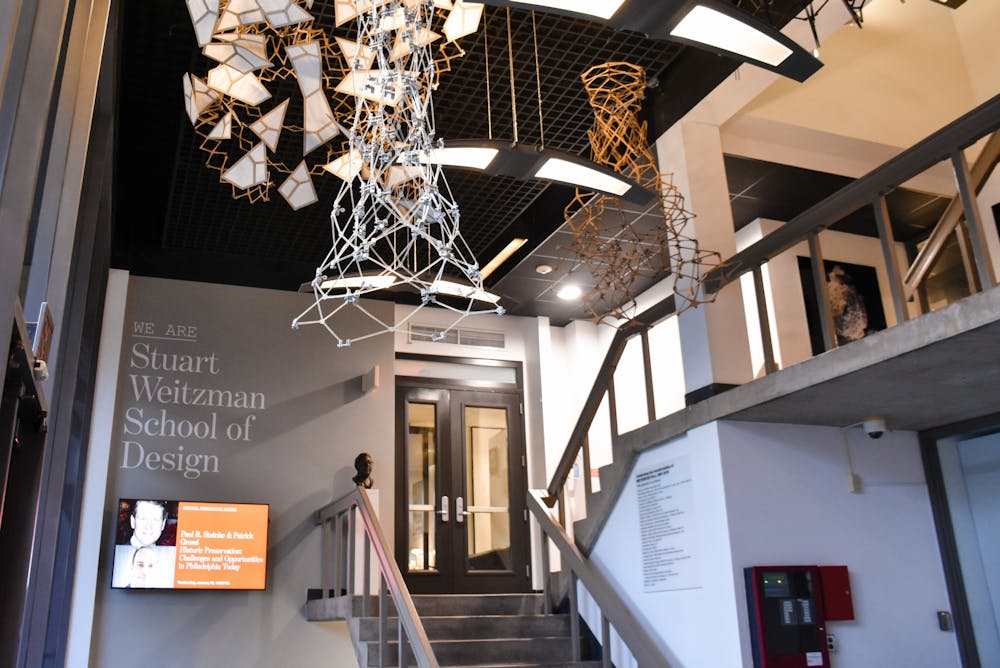
The Weitzman School will have one of the few architectural programs in the nation to use robots and artificial intelligence in design.
Credit: Mona LeePenn’s Stuart Weitzman School of Design will offer a new masters degree program this fall that specializes in using robotics for architecture and design.
The new program is known as Master of Science in Design: Robotics and Autonomous Systems (MSD-RAS), and it is one of the few architectural programs in the nation to use robots and artificial intelligence in design, according to Miller Professor and Chair of Architecture Winka Dubbeldam. The degree requires ten courses and can be completed in nine months.
Assistant Professor of Architecture and MSD-RAS Program Director Robert Stuart-Smith said his motivation to introduce the new program was to keep up with the changing architectural industry, which now relies more on automation, robotic engineering, and software design.
“We feel almost an obligation to make sure our graduates are trained for a career that is based on present and near-future changes in the industry,” Stuart-Smith said.
The degree allows students to gain hands-on technical robotics experience. Students will utilize ABB IRB 4600 industrial robots in the Autonomous Manufacturing Lab (AML), led by Stuart-Smith. They will also have access to other labs in Weitzman, all of which are a part of the Advanced Research and Innovation Lab (ARI), led by Dubbeldam.
“Students will learn specific skills like scripting, software, and how to program these robots to create designs,” Dubbeldam said. “Our program distinguishes itself because Penn also has higher engineering in robotics, allowing us to collaborate with Penn Engineering literally right across from us,” she added.
The MSD-RAS program aims to push boundaries in the field of architecture, Assistant Professor of Architecture Masoud Akbarzadeh said.
“Robotics and autonomous technology can give architects the ability to go beyond existing conventions and restraints,” he said.
Mariana Righi, a former School of Design student and current Autonomous Manufacturing Lab operator and researcher, said that her experience in the graduate program helped her learn how to code, an important component of the new robotics program.
Righi believes coding is also an important skill to hone for those who want to pursue architecture.
First-year design student Mia Kim said she is intrigued by the program and believes the MSD-RAS degree is at the forefront of design technology. However, she stressed the importance of balancing ethical responsibility with automation.
“Automation and robotics opens the door for a new era of design and raises the challenge of balancing ethical design with efficient design," Kim said.
Stuart-Smith and Dubbledam both emphasized they want students in the program to be "critically aware" of the environmental impact of their work.
"We're thinking about the environment, the life cycle, and trying to put humanity within an ethical approach to automation of robotics," Stuart-Smith said.
An ongoing collaborative project between Akbarzadeh and Stuart-Smith is one example of how students in the program might use robotics in tandem with architecture. Akbarzadeh and Stuart-Smith are using robotics to construct a full-scale concrete house.
Dubbeldam wants students to expand their idea of what it means to be an architect.
“I think what’s really important is to work on the role of the architect: to get out of the corner that is only designer. Ten percent of the role is to design and 90% is realizing the design,” she said.
The Daily Pennsylvanian is an independent, student-run newspaper. Please consider making a donation to support the coverage that shapes the University. Your generosity ensures a future of strong journalism at Penn.
Donate




